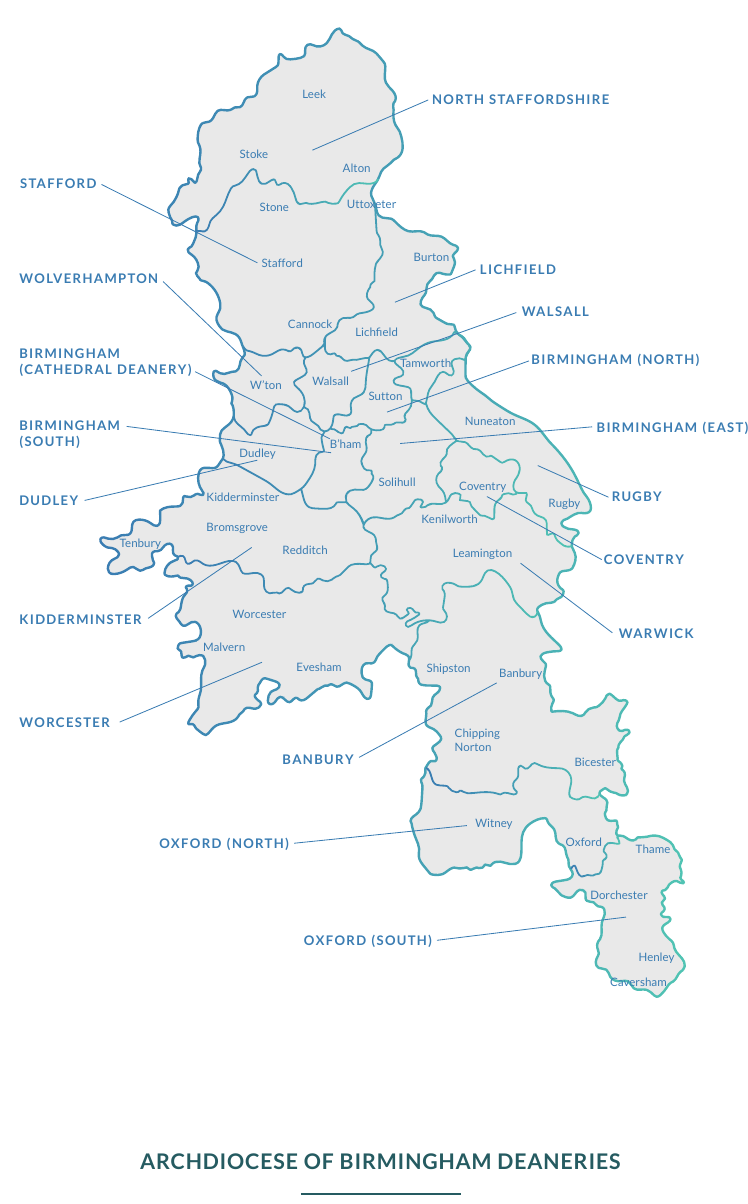B.1: The structure of the Roman Catholic Church and the Archdiocese of Birmingham
1. The Pope is the head of the Roman Catholic Church. He is supported by a number of organisations and bodies that make up the Holy See, the central administration of the Roman Catholic Church which includes the Pope and the offices of the Vatican. The Roman Catholic Church is governed by a system of laws known as the Code of Canon Law. The current code is the 1983 Code of Canon Law.
2. The Roman Catholic Church has local branches of the Church in the form of geographical areas known as dioceses and archdioceses. There are 22 dioceses and archdioceses in England and Wales. Within a diocese and archdiocese, the bishop or archbishop must abide by canon law but is otherwise autonomous. No archbishop in England and Wales has authority over any other archbishop, likewise with the bishops. An archbishop does not have authority over a bishop.
3. Within each archdiocese or diocese, there are a number of parishes and each parish is served by a parish priest. The Archdiocese of Birmingham consists of approximately 225 parishes. As shown below, the Archdiocese of Birmingham covers a large geographical area.

4. In 2014, Archbishop Vincent Nichols, the Archbishop of Westminster, was made a cardinal by Pope Francis. Cardinals usually also hold the rank of archbishop and together they form the College of Cardinals, whose primary responsibility is to elect a new pope. A cardinal does not have authority over an archbishop or bishop and so it is a misconception to refer to Cardinal Nichols as the ‘head’ of the Roman Catholic Church in England and Wales.
5. All of the archbishops and bishops in England and Wales are collectively known as the ‘Catholic Bishops’ Conference for England and Wales’ (the Conference). The Conference meets twice a year. The current President of the Conference is the Archbishop of Westminster, Archbishop Nichols. If the Conference wishes to pass a law applicable in England and Wales then approval must be sought from the Holy See. However, if the Pope wishes to issue a directive he will issue it directly to the individual archbishop or bishop.
6. In an archdiocese as large as Birmingham, the archbishop has great responsibility and power. The current incumbent, Archbishop Bernard Longley, is assisted by auxiliary bishops who help him serve the archdiocese.
7. In relation to matters of child protection and safeguarding, the recommendations in the Nolan and Cumberlege reports proposed many changes to the way the Church handled allegations of child sexual abuse. However, as Archbishop Longley said, responsibility for safeguarding within the Archdiocese of Birmingham rests with him.[1]
Religious orders
8. There are now 60 Roman Catholic religious orders (also referred to as religious institutes or religious congregations) operating within the Archdiocese of Birmingham. These range in size from an order with two religious sisters to orders containing 25 to 30 members. A religious order cannot operate within an archdiocese or diocese without the permission of the archbishop or bishop. However, each religious order is governed by its own constitution and the archbishop is required by canon law to respect the right of the religious order to self-govern.
9. Since 2013, it has been the policy within the Archdiocese of Birmingham that any religious order operating within it must be aligned to either the Birmingham Safeguarding Commission or another safeguarding commission. Archbishop Longley told us that this was to ensure that national policies would be followed and to demonstrate the Archdiocese’s commitment to following the ‘One Church’ policy that was advocated by the Cumberlege review. [2] Archbishop Longley stated that although he could not compel an order to align with a safeguarding commission, he does have the power to revoke permission for that order to remain within the Archdiocese. This is not a power he has ever had to use and he stated that all 60 orders within his Archdiocese are aligned to a safeguarding commission.
Historic response to allegations of child sexual abuse
10. Before the late 1990s, when allegations of child sexual abuse were made against a member of the clergy within the Archdiocese of Birmingham, the Archbishop and the Vicar General [3] were informed. Both were responsible for investigating the allegation and then taking whatever action was considered necessary. [4] However, this process lacked formality and there was no set procedure for how an investigation should be handled. Although in some instances notes of a complaint were made and kept on an individual’s personal file, some files contained scant detail about the allegation and any subsequent investigation.